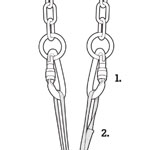Bolted Toprope Anchors

"Bolted-Toprope-Anchors-158"
Once you start venturing outside the gym to pull on real rock, you or your climbing partner might not be quite ready to tie into the sharp end, so it’s essential to know how to set up a solid anchor for toproping. Many climbs have two bolts (or chains or rings attached to bolts) at the top, making it easy to establish a secure toprope. Once you master this setup, you can climb worry-free and focus on getting stronger and having fun.
Warning: This technique only applies if you have safe access to the top of a cliff, where bolt anchors are often placed. Anchor yourself to a tree or crack with a long sling or length of rope before approaching the cliff edge to set up a toprope.

The Gear
You’ll need four locking carabiners and a double-length sling (48”). Wider slings (3/4” or 1”) are generally more durable. You can use pre-sewn slings or an appropriate length of loose webbing tied with a tight water knot. (See Climbing 308.) Alter your sling length if the setup causes the sling or rope to rub over the edge of the cliff or a block.
- Clip In. Clip one locking carabiner through each bolt/ring/chain (ideally the bolt hanger), and then clip the sling into each locking biner. Lock these biners now so you won’t forget later. Following the same steps in the same order each time will help you avoid mistakes.
- Equalize the Sling. Pull the sling down so that each hanging loop is even and the bartacking (or water knot) is close to one of the biners clipped to a bolt, but not in direct contact. This keeps the bulkiest part of the sling out of the way of the master point. Gather all four strands of webbing hanging down, and pull the loops in the direction of the climb to equalize the tension on each bolt.
- Create a Master Point. Tie a figure eight on a bight with all four strands. The knot makes each arm of the anchor independent, providing redundancy in case one side should fail. Pull the knot snug, and make sure it’s clean and well-dressed—no big gaps.
- Clip the Rope. Clip two locking biners through both strands of the figure-eight bight. Make sure to oppose the gates (have them facing different directions). Clip the rope through each biner and lock them. You’re good to go.
Related: How to Identify Bad Climbing Bolts
Anchor Options
- Two shoulder-length (24”) slings can be used instead of a single 48” sling, by clipping one to each bolt. It will be harder to equalize the anchor if the bolts are at different heights. Try doubling one sling, extending it with a quickdraw, or girth-hitching a second sling to the first.
- The standard anchor setup used by sport-climbing leaders can also be used to set up a toprope. Clip a quickdraw to each bolt and clip the rope through the lower carabiners on the draws. Two essentials: 1) Make sure the gates are opposed on the lower biners, so the rope can’t come unclipped. Using locking carabiners on one or both draws is safest. 2) Make sure the upper biners are not positioned in a way that they can be pried open by the anchor chains or the rock. Clipping into the rings at the end of the chains is best, and once again, locking biners will make the system safer.
- Setting up toprope anchors on trees is a common practice—so much so that many people will leave slings and other gear for a permanent anchor. (Make sure to get proper instruction before setting up your own toprope anchor on a tree.) Before using an existing anchor, double-check the quality of the gear and the tree. The tree should be alive, at least five inches in diameter, and well-rooted (i.e., not just sitting in a thin layer of duff). The slings and other fixed gear should not be cut or torn at all, and there should be minimal fraying or fading. If there is anythingthat looks suspicious, don’t trust it. Build your own anchor instead.
- Gear inspection goes for bolts, chains, and rings, too. They should all be relatively rust-free without any major wear spots, and bolts should be tightened.